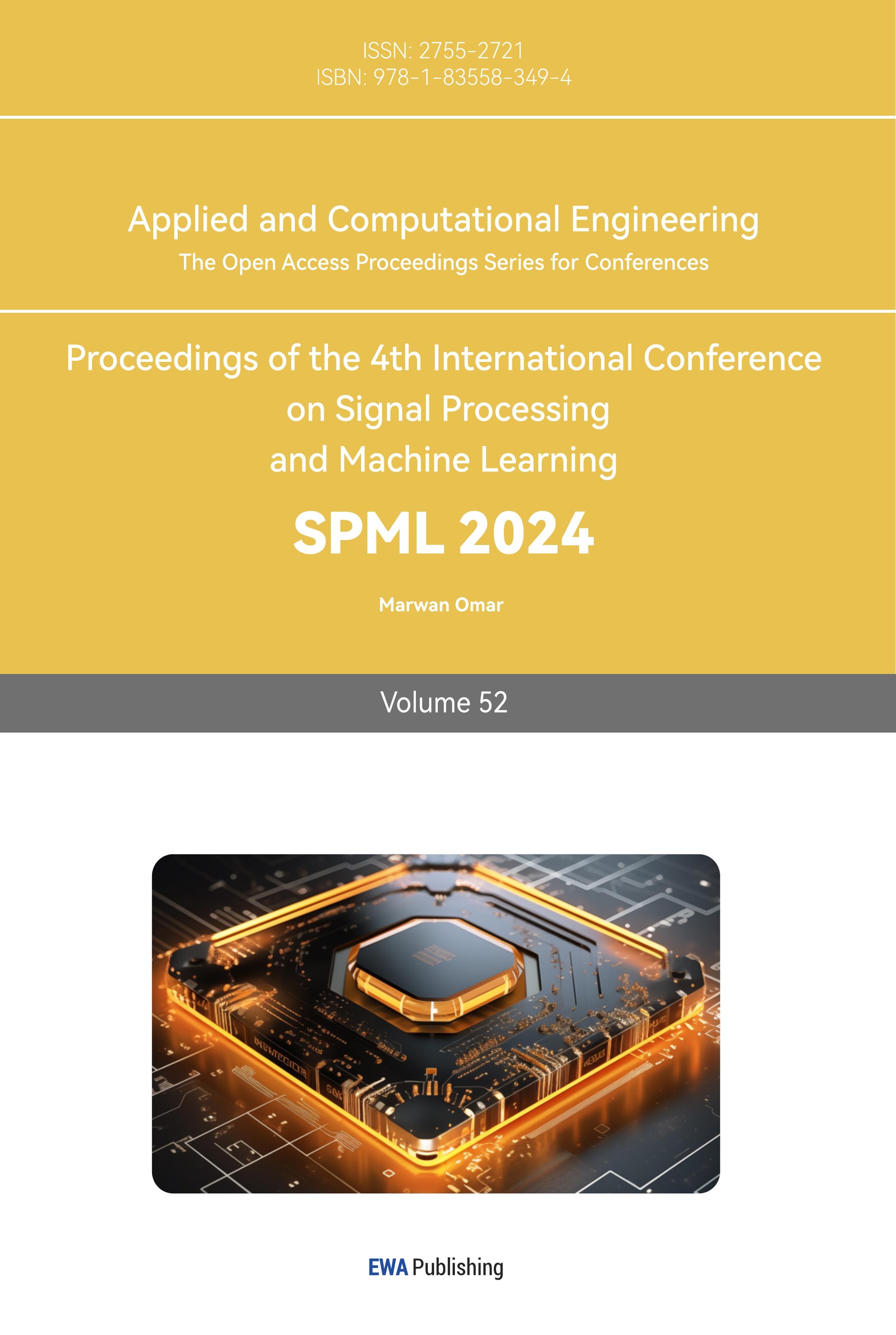1. Introduction
Virtual Reality (VR) technology is a technology that can create virtual environments that seem to be in the middle of the real world, and it has been widely used in the fields of gaming, training, and healthcare [1]. In a VR environment, users can interact with the virtual environment through head-mounted displays, joysticks, and other devices, and this type of interaction allows users to feel the scenes and situations in the virtual environment in a more immersive way, thus improving the user's participation and experience [2]. However, the development of virtual reality technology still faces some challenges, and one of the important challenges is how to improve the user's sense of experience in the VR environment [3]. This requires in-depth research and analysis of users' perception, attention, and emotion in VR environments [4]. In order to better understand the user's sense of experience in VR environments, researchers have used a variety of methods to analyze the data [5].
First, researchers can monitor and record users' physiological responses in VR environments through sensors and other devices. These physiological responses include heart rate, skin resistance, eye movement, etc., which can reflect the user's cognitive and emotional state of the virtual environment [6]. Through the analysis of these physiological responses, researchers can understand the emotional changes of users in different scenarios, and then optimize the design and interaction of the virtual environment to improve the user's experience [7].
Secondly, researchers can also understand users' subjective feelings towards VR environments through questionnaires and other means [8]. These questionnaires include questions on user satisfaction, emotional response, attention, etc., which can help researchers understand the subjective experience and feelings of users [9]. By analyzing the results of these questionnaires, researchers can find out what users' preferences and needs are for different aspects of virtual environments, so as to further optimize the design of virtual environments and the way of interaction, and to improve the users' experience [10].
Finally, researchers can also understand how users behave and interact in VR environments through behavioral analyses and other means. These behavioral analyses include the user's movement trajectory, gesture interactions, and other aspects, which can help researchers understand the user's behavior and interaction style in the virtual environment. By counting and analyzing the results of these behavioral analyses, researchers can discover the patterns and trends of users' behaviors and interaction styles in virtual environments, so as to further optimize the design of virtual environments and interaction styles, and to improve the users' sense of experience.
In summary, data analysis plays an important role in studying users' experience in virtual reality environments. By analyzing a variety of data such as users' physiological responses, questionnaires and behavioral analysis, we can understand the characteristics of users' cognition, emotions and behaviors in virtual environments, so as to optimize the design of virtual environments and interaction methods, and improve users' sense of experience.
2. Data set visualization
With the continuous development of virtual reality (VR) technology, more and more people are using VR devices to experience virtual environments. However, the design of virtual environments and the way of interaction have a great impact on the user's sense of experience. In order to improve users' sense of experience in VR environments, researchers need to understand users' physiological responses, emotional states, and preferences in different scenarios, which requires collecting and analyzing a large amount of data. Therefore, researchers developed a dataset containing users' experiences in VR environments with the aim of enhancing VR technology by analyzing user experiences.
The dataset includes data related to users' physiological responses, emotional states, and user preferences in the VR environment. Among them, physiological reactions include indicators such as heart rate and skin conductivity, which can reflect users' physiological reactions and emotional states in different scenarios. Emotional state includes the user's emotional response in different scenes, such as happy, sad, surprised, etc. User preference includes the user's preference for different scenes, preference for different interaction methods, and so on. By analyzing these data, researchers can understand how users feel about their experiences in different scenarios, so as to optimize the design of VR environments and interaction methods, and to improve the user's sense of experience. Some of the data are shown in Figure 1.
The purpose of this dataset is to enhance VR technology by analyzing user experience. By collecting and analyzing data such as users' physiological reactions, emotional states and user preferences in different scenarios, researchers can understand the characteristics of users' cognition, emotions and behaviors in VR environments, and thus optimize the design of VR environments and the way of interaction to improve users' sense of experience. The dataset can help developers optimize VR systems and create tailored experiences that improve immersion and overall user satisfaction.
In summary, the development and application of this dataset will have a significant impact on the development and application of VR technology. By collecting and analyzing data on users' experiences in VR environments, researchers can optimize the design and interaction methods of VR environments and improve the user experience, thus promoting the development and application of VR technology.
Table 1. Partial data presentation. | ||||||
UserID | Age | Gender | VRHeadset | Duration | MotionSickness | Immersion Level |
1 | 40 | Male | HTC Vive | 13.598508 | 8 | 5 |
2 | 43 | Female | HTC Vive | 19.950815 | 2 | 2 |
3 | 27 | Male | PlayStation VR | 16.543387 | 4 | 2 |
4 | 33 | Male | HTC Vive | 42.574083 | 6 | 3 |
5 | 51 | Male | PlayStation VR | 22.452647 | 4 | 2 |
3. Exploratory analysis of data
Immersion is used to measure how immersive a user feels in a VR experience. It represents the subjective level of immersion reported by users and can be measured on a scale of 1 to 5, with 5 indicating the highest level of immersion.
First, the percentage of each level of immersion 1-5 was counted and represented in pie charts and bar charts, as shown in Figure 1. As can be seen from Figure 1, the distribution of the data is relatively even, with roughly the same number of people at each level of immersion.
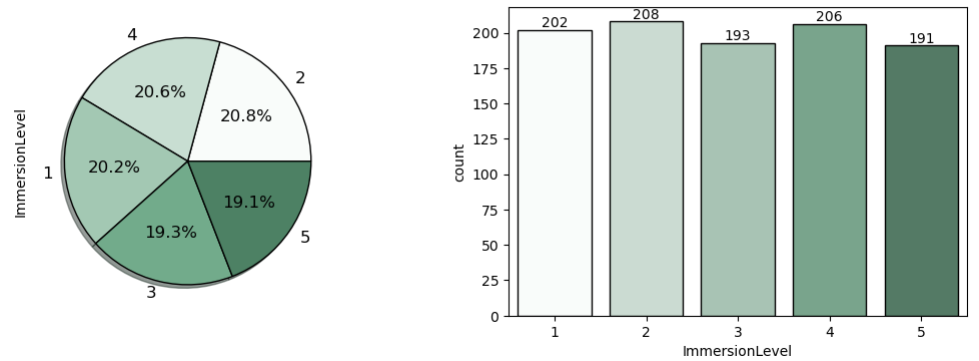
Figure 1. Statistical data charts.
(Photo credit: Original)
Second, the distribution of the data according to different age groups using the bar chart statistics is shown in Figure 2. As can be seen in Figure 1, the distribution of the data is relatively even in terms of age, with roughly the same number of people at each level of immersion.
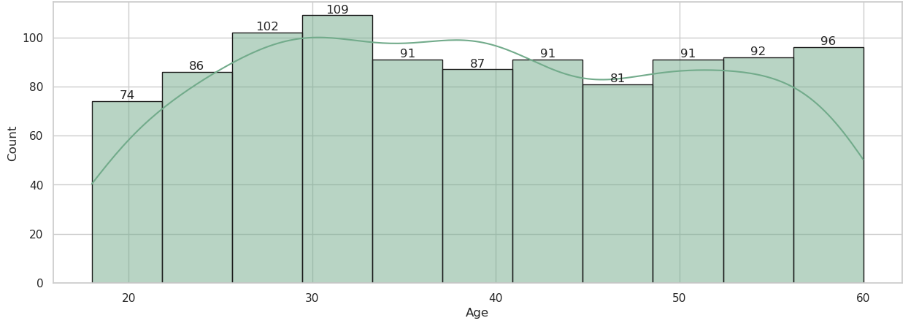
Figure 2. Statistical data charts.
(Photo credit: Original)
Then, the different age groups were divided into different groups corresponding to the six groups from 1-6, and the percentages of the number of people with various levels of immersion were counted separately using bar charts, as shown in Figure 3.
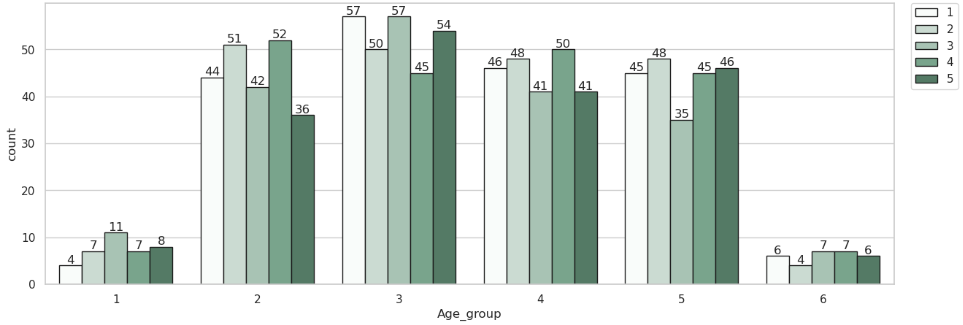
Figure 3. Statistical data charts.
(Photo credit: Original)
In addition, gender may also be an important factor influencing the level of VR immersion, using bar charts to count the proportion of people in the groups of different genders with various levels of immersion, and the results are shown in Figure 4.
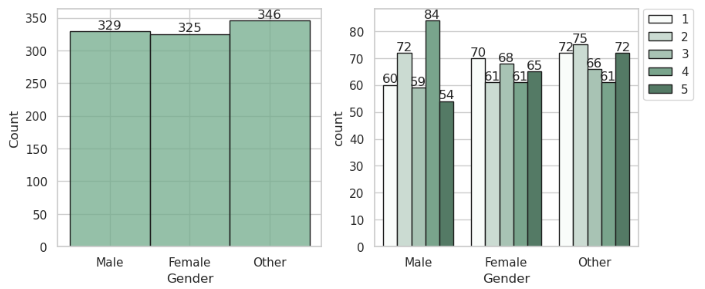
Figure 4. Statistical data charts.
(Photo credit: Original)
Secondly, the length of time wearing a VR helmet is also an important factor affecting the sense of VR experience, this paper according to the length of time wearing a VR helmet will be divided into five groups of 1-5, and then the distribution of the number of people in the five groups of each degree of immersion, histogram shown in Figure 5.

Figure 5. Statistical data charts.
(Photo credit: Original)
Finally, physiological reasons are also important factors that lead to different VR immersion for different people, for example, some people are prone to vertigo when experiencing VR, and this paper uses bar charts to statistically measure the effect of vertigo on the level of immersion, as shown in Figure 6.
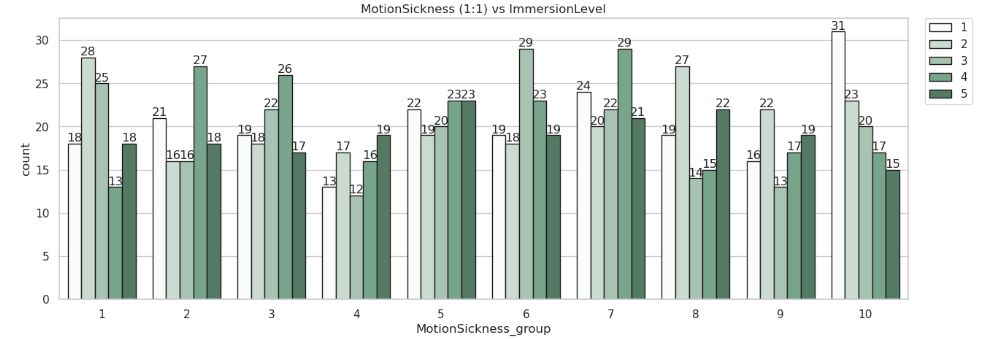
Figure 6. Statistical data charts.
(Photo credit: Original)
According to the study, the majority of users are between the ages of 30 and 40, with the immersion levels of each age group largely balanced. This shows that VR technology is not something that only young people can enjoy, but that people of all ages can feel the immersion it provides. In addition, the number of each gender is almost the same, with a balanced ratio of four immersion levels for most men and five immersion levels for women. This also shows that VR technology is not just for men or women, but for all people.
When it comes to the choice of VR headset, most users use the Oculus Rift, this is because the Oculus Rift delivers the best experience. This can be seen in the Oculus Rift's share of the VR market, which is far more than other brands of VR headsets. This also shows the leadership of Oculus Rift in VR technology.
In terms of duration of VR headsets, users with a duration of less than 20 minutes are less immersed and the longer the duration, the higher the immersion. This is because in a short period of time, users are not able to fully immerse themselves in the VR experience, whereas in a longer duration, users can better adapt to the VR environment and thus feel the immersion more deeply.
Finally, the effect of motion sickness on the VR experience is also an important factor. The more severe the motion sickness, the lower the immersion. This is because motion sickness makes users feel uncomfortable, which affects their immersion. Therefore, in VR experience, we need to pay attention to the user's physical condition to minimize the effect of motion sickness and improve the user's immersion.
In conclusion, the level of immersion is one of the important indicators to measure the user's immersion in VR experience. In the application of VR technology, we need to consider the user's age, gender, choice of VR headset, duration, and motion sickness to improve the user's immersion and experience.
4. Analysis of results
Immersion level is one of the most important metrics for measuring a user's immersion in a VR experience. This metric represents the subjective immersion reported by users and can be measured on a scale of 1 to 5, with 5 indicating the highest level of immersion. Factors such as age, choice of VR headset, duration, and motion sickness can affect user immersion.
First, age is an important factor in user immersion. Studies have shown that the older the age and the longer the duration, the more immersive the user is. This is because older users are more mature, more rational, and better able to adapt to the VR environment, thus feeling the immersion more deeply. Additionally, the older the user, the more immersive they feel with the Oculus Rift. This may be due to the fact that the Oculus Rift is designed to be more responsive to the needs of older users, thus increasing their immersion.
Second, there are some differences in immersion by age and gender. Research shows that immersion is higher for men aged 30-36, women aged 32-35, and others aged 34-40. This may be due to the fact that users in these age groups are more mature and better able to adapt to the VR environment. Additionally, males using the HTC Vive experience higher levels of immersion, while females and others using the Oculus Rift experience higher levels of immersion. This may be due to the fact that different VR headsets have different designs and features, which affects the user's immersion.
Thirdly, the choice and duration of the VR headset is also an important factor that affects the user's immersion. Different VR headsets are suitable for users of different age groups and genders. For example, HTC Vive is most suitable for users under 30 years old, Playstation VR is most suitable for users aged 30-50 years old, and Oculus Rift is most suitable for users over 50 years old. Additionally, users of different durations will also experience different levels of immersion. Studies have shown that the Oculus Rift provides the best experience for users under 10 minutes and over 40 minutes, while the HTC Vive has a better experience for durations of 10-40 minutes. This could be due to the differences in design and functionality of different VR headsets, which affects the user's immersion.
Finally, motion sickness is also one of the major factors that affects user immersion. The study showed that the lowest level of motion sickness but the best duration of the experience was 31 minutes. In addition, Oculus Rift users had the lowest motion sickness but the best experience. This may be due to the fact that the Oculus Rift is designed to be more ergonomic, which reduces user discomfort. Male users were most immersed at 23-31 minutes, female users were most immersed at 23-31 minutes, and other users were most immersed at 26-33 minutes. This may be due to the fact that users of different genders and age groups have different adaptability to the VR experience, which affects their immersion.
In summary, immersion level is one of the most important indicators of user immersion in a VR experience. Factors such as age, choice of VR headset, duration and motion sickness all affect the user's immersion. In the application of VR technology, we need to consider the user's age, gender, choice of VR helmet, duration, and motion sickness in order to improve the user's immersion and experience.
5. Conclusion
Based on the above conclusions, we can see that factors such as age, gender, use of equipment, duration and so on have a greater impact on the immersion and degree of motion sickness in VR experience. Therefore, we need to make choices and adjustments according to our own situation when conducting VR experiences in order to get the best experience.
First of all, age is an important factor affecting immersion and motion sickness level. According to research, the older you are, the stronger the immersion and the lower the level of motion sickness. Therefore, for older users, it is recommended to choose Oculus Rift for the experience to get better immersion and less motion sickness symptoms.
Secondly, gender and the device used can also have an impact on immersion and motion sickness levels. According to the study, the HTC Vive is better suited for younger male users, the Playstation VR is better suited for users between the ages of 30 and 50, and the Oculus Rift is better suited for users over the age of 50. In addition, women and others experience a higher level of immersion with the Oculus Rift, while men experience a higher level of immersion with the HTC Vive. Therefore, when choosing a device, you need to consider your gender and age and choose the most suitable device for you.
In addition, duration can also have an impact on immersion and level of motion sickness. According to research, the Oculus Rift provides the best experience for users of less than 10 minutes and more than 40 minutes, while the HTC Vive has a better experience for durations of 10-40 minutes. Therefore, when engaging in a VR experience, you need to choose and adjust the duration of your experience to get the best out of it.
Finally, for users with high levels of motion sickness, it is recommended to choose a VR experience with a shorter duration to minimize the occurrence of motion sickness symptoms. In addition, proper rest and adjustments can be made before the VR experience to alleviate motion sickness symptoms.
In conclusion, choosing the most suitable VR experience for you based on factors such as age, gender, equipment used and duration can result in better immersion and fewer motion sickness symptoms. When performing VR experiences, you need to make choices and adjustments according to your own situation to get the best experience.
References
[1]. Ashraf A ,Atasi M .Implications of virtual reality (VR) for school teachers and instructional designers: An empirical investigation[J].Cogent Education,2023,10(2):
[2]. JS K ,N J ,TZ R , et al.9552 Validation of a Multidisciplinary Virtual Reality (VR) Robotic Surgical Curriculum[J].The Journal of Minimally Invasive Gynecology,2023,30(11S):S74-S75.
[3]. Ouerghemmi C ,Ertz M ,Bouslama N , et al.The Impact of Virtual Reality (VR) Tour Experience on Tourists’ Intention to Visit[J].Information,2023,14(10):
[4]. H K ,Eun S K ,Kwangsoo P , et al.Exploring the role of flow experience and telepresence in virtual reality (VR) concerts[J].Journal of Travel Tourism Marketing,2023,40(7):568-582.
[5]. S J K ,Nicholas J ,Zaihra T R , et al.Validation of a multidisciplinary virtual reality (VR) robotic surgical curriculum.[J].Journal of robotic surgery,2023,17(5):2495-2502.
[6]. Victor A ,E H J ,Nusaiba B , et al.Augmenting Medical and Surgical Education with Virtual Reality (VR).[J].Plastic and reconstructive surgery,2023,152(3):556e-558e.
[7]. Ioulia M ,Adriana S L ,Jan P M .From capture to texture: affective environments for theatre training in virtual reality (VR)[J].Theatre and Performance Design,2023,9(1-2):52-73.
[8]. R E M ,Allison S .Abstract WMP21: Virtual Reality Module For Stroke Education[J].Stroke,2023,54(Suppl_1):AWMP21-AWMP21.
[9]. Soma S ,Biswash N S T ,Heping C .High accuracy keyway angle identification using VGG16-based learning method[J].Journal of Manufacturing Processes,2023,98
[10]. Wen S ,Yang L ,Duan H , et al.Pavement Recognition Based on Improving VGG16 Network Model[J].International Journal of New Developments in Engineering and Society,2023,7(3):
Cite this article
Peng,X. (2024). Research and recommendations on user immersion in Virtual Reality (VR) technology based on data mining. Applied and Computational Engineering,52,285-291.
Data availability
The datasets used and/or analyzed during the current study will be available from the authors upon reasonable request.
Disclaimer/Publisher's Note
The statements, opinions and data contained in all publications are solely those of the individual author(s) and contributor(s) and not of EWA Publishing and/or the editor(s). EWA Publishing and/or the editor(s) disclaim responsibility for any injury to people or property resulting from any ideas, methods, instructions or products referred to in the content.
About volume
Volume title: Proceedings of the 4th International Conference on Signal Processing and Machine Learning
© 2024 by the author(s). Licensee EWA Publishing, Oxford, UK. This article is an open access article distributed under the terms and
conditions of the Creative Commons Attribution (CC BY) license. Authors who
publish this series agree to the following terms:
1. Authors retain copyright and grant the series right of first publication with the work simultaneously licensed under a Creative Commons
Attribution License that allows others to share the work with an acknowledgment of the work's authorship and initial publication in this
series.
2. Authors are able to enter into separate, additional contractual arrangements for the non-exclusive distribution of the series's published
version of the work (e.g., post it to an institutional repository or publish it in a book), with an acknowledgment of its initial
publication in this series.
3. Authors are permitted and encouraged to post their work online (e.g., in institutional repositories or on their website) prior to and
during the submission process, as it can lead to productive exchanges, as well as earlier and greater citation of published work (See
Open access policy for details).
References
[1]. Ashraf A ,Atasi M .Implications of virtual reality (VR) for school teachers and instructional designers: An empirical investigation[J].Cogent Education,2023,10(2):
[2]. JS K ,N J ,TZ R , et al.9552 Validation of a Multidisciplinary Virtual Reality (VR) Robotic Surgical Curriculum[J].The Journal of Minimally Invasive Gynecology,2023,30(11S):S74-S75.
[3]. Ouerghemmi C ,Ertz M ,Bouslama N , et al.The Impact of Virtual Reality (VR) Tour Experience on Tourists’ Intention to Visit[J].Information,2023,14(10):
[4]. H K ,Eun S K ,Kwangsoo P , et al.Exploring the role of flow experience and telepresence in virtual reality (VR) concerts[J].Journal of Travel Tourism Marketing,2023,40(7):568-582.
[5]. S J K ,Nicholas J ,Zaihra T R , et al.Validation of a multidisciplinary virtual reality (VR) robotic surgical curriculum.[J].Journal of robotic surgery,2023,17(5):2495-2502.
[6]. Victor A ,E H J ,Nusaiba B , et al.Augmenting Medical and Surgical Education with Virtual Reality (VR).[J].Plastic and reconstructive surgery,2023,152(3):556e-558e.
[7]. Ioulia M ,Adriana S L ,Jan P M .From capture to texture: affective environments for theatre training in virtual reality (VR)[J].Theatre and Performance Design,2023,9(1-2):52-73.
[8]. R E M ,Allison S .Abstract WMP21: Virtual Reality Module For Stroke Education[J].Stroke,2023,54(Suppl_1):AWMP21-AWMP21.
[9]. Soma S ,Biswash N S T ,Heping C .High accuracy keyway angle identification using VGG16-based learning method[J].Journal of Manufacturing Processes,2023,98
[10]. Wen S ,Yang L ,Duan H , et al.Pavement Recognition Based on Improving VGG16 Network Model[J].International Journal of New Developments in Engineering and Society,2023,7(3):





